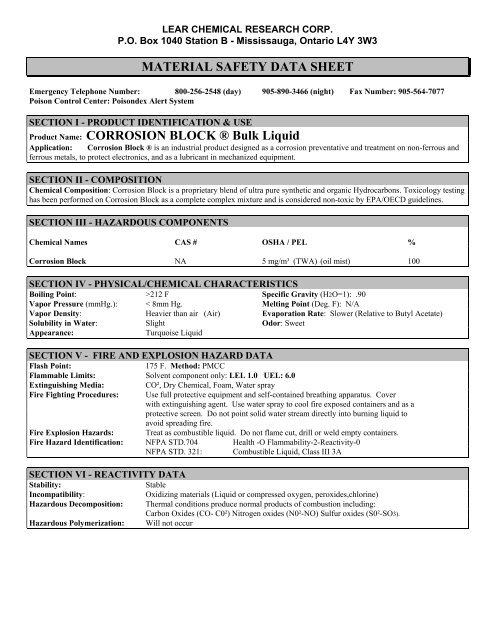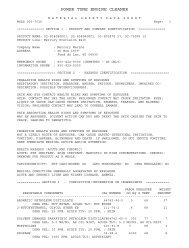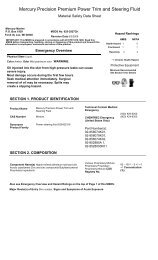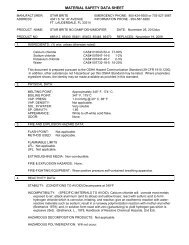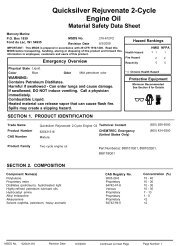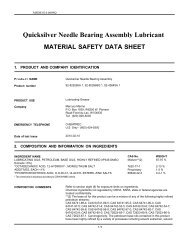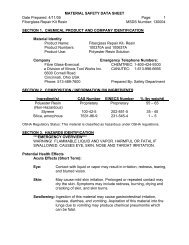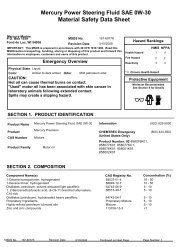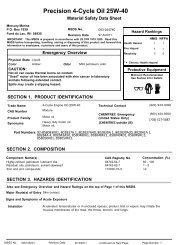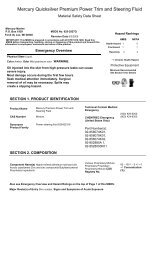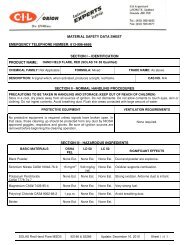Get the MSDS sheet - Midwest Corrosion Products
Get the MSDS sheet - Midwest Corrosion Products
Get the MSDS sheet - Midwest Corrosion Products
You also want an ePaper? Increase the reach of your titles
YUMPU automatically turns print PDFs into web optimized ePapers that Google loves.
LEAR CHEMICAL RESEARCH CORP.<br />
P.O. Box 1040 Station B - Mississauga, Ontario L4Y 3W3<br />
MATERIAL SAFETY DATA SHEET<br />
Emergency Telephone Number: 800-256-2548 (day) 905-890-3466 (night) Fax Number: 905-564-7077<br />
Poison Control Center: Poisondex Alert System<br />
SECTION I - PRODUCT IDENTIFICATION & USE<br />
Product Name: CORROSION BLOCK ® Bulk Liquid<br />
Application: <strong>Corrosion</strong> Block ® is an industrial product designed as a corrosion preventative and treatment on non-ferrous and<br />
ferrous metals, to protect electronics, and as a lubricant in mechanized equipment.<br />
SECTION II - COMPOSITION<br />
Chemical Composition: <strong>Corrosion</strong> Block is a proprietary blend of ultra pure syn<strong>the</strong>tic and organic Hydrocarbons. Toxicology testing<br />
has been performed on <strong>Corrosion</strong> Block as a complete complex mixture and is considered non-toxic by EPA/OECD guidelines.<br />
SECTION III - HAZARDOUS COMPONENTS<br />
Chemical Names CAS # OSHA / PEL %<br />
<strong>Corrosion</strong> Block NA 5 mg/m³ (TWA) (oil mist) 100<br />
SECTION IV - PHYSICAL/CHEMICAL CHARACTERISTICS<br />
Boiling Point: >212 F Specific Gravity (H2O=1): .90<br />
Vapor Pressure (mmHg.): < 8mm Hg. Melting Point (Deg. F): N/A<br />
Vapor Density: Heavier than air (Air) Evaporation Rate: Slower (Relative to Butyl Acetate)<br />
Solubility in Water: Slight Odor: Sweet<br />
Appearance:<br />
Turquoise Liquid<br />
SECTION V - FIRE AND EXPLOSION HAZARD DATA<br />
Flash Point:<br />
175 F. Method: PMCC<br />
Flammable Limits: Solvent component only: LEL 1.0 UEL: 6.0<br />
Extinguishing Media:<br />
CO², Dry Chemical, Foam, Water spray<br />
Fire Fighting Procedures: Use full protective equipment and self-contained breathing apparatus. Cover<br />
with extinguishing agent. Use water spray to cool fire exposed containers and as a<br />
protective screen. Do not point solid water stream directly into burning liquid to<br />
avoid spreading fire.<br />
Fire Explosion Hazards: Treat as combustible liquid. Do not flame cut, drill or weld empty containers.<br />
Fire Hazard Identification: NFPA STD.704 Health -O Flammability-2-Reactivity-0<br />
NFPA STD. 321: Combustible Liquid, Class III 3A<br />
SECTION VI - REACTIVITY DATA<br />
Stability:<br />
Stable<br />
Incompatibility:<br />
Oxidizing materials (Liquid or compressed oxygen, peroxides,chlorine)<br />
Hazardous Decomposition: Thermal conditions produce normal products of combustion including:<br />
Carbon Oxides (CO- C0²) Nitrogen oxides (N0²-NO) Sulfur oxides (S0²-SO3).<br />
Hazardous Polymerization: Will not occur
MATERIAL SAFETY DATA SHEET - PAGE 2 - <strong>Corrosion</strong> Block Bulk Liquid<br />
SECTION VII - TOXICOLOGICAL PROPERTIES<br />
<strong>Corrosion</strong> Block Bulk Liquid has been tested (oral, eye, dermal) as a complete mixture and is considered “Non-Toxic”<br />
according to EPA /OCED and FHSA guidelines.<br />
Primary Routes of entry:<br />
Acute Oral: LD50 > 5000 mg/kg Acute Eye: LC50 > 5000 mg/kg<br />
Acute Dermal: LD50 > 5000 mg/kg Acute Vapor LC50 > 5000 ppm -Rat-Aliphatic hydrocarbon<br />
(est.)<br />
LC50 > 5000 ppm -Rat-Petroleum distillate<br />
Carcinogenicity: Non-carcinogenic, according to NTP, IARC, OSHA or ACGIH.<br />
Sensitization:<br />
Non-sensitizer<br />
Mutagenic effects: No Tetragenic: No<br />
Reproductive: No Developmental: No<br />
EFFECTS OF OVEREXPOSURE:<br />
Inhalation:<br />
May cause headache, nausea, or dizziness.<br />
Skin and Eyes: May cause drying or chapping of skin. May cause redness of eyes<br />
Ingestion:<br />
May be harmful or fatal if swallowed.<br />
SECTION VIII - EMERGENCY AND FIRST AID PROCEDURES<br />
Skin: Remove excess by wiping, followed by washing with soap and water.<br />
Eyes: Copious warm water flush for 15 minutes, Physician assessment if eyes inflamed.<br />
Inhalation: Evacuate to fresh air. Apply CPR if required. If resuscitation was required <strong>the</strong>n a physician’s assessment is<br />
mandatory.<br />
Ingestion: DO NOT INDUCE VOMITING. Give 1/2 pint milk to drink. If vomiting takes place naturally, lean victim<br />
forward to prevent aspiration into lungs. Aspiration into <strong>the</strong> lungs may cause chemical pneumontis, which can be<br />
fatal. Mandatory physician assessment.. Note to Physician:Consult standard literature for Hydrocarbon poison.<br />
SECTION IX - PREVENTIVE MEASURES<br />
Steps to be taken if Spilled: Eliminate sources of ignition - Stop or reduce flow with barricades - Absorb small spills using<br />
dry clay, commercial sorbents. Collect residue into suitable container for disposal. Material may<br />
be drained into floor drains equipped with Oil Interceptors.<br />
Waste Disposal Method: Dispose in approved landfill site or incinerate at licensed waste reclaim facility. Liquid waste to<br />
be removed by licensed reclaimer, under Used Oil Classification. Follow all Local, Provincial,<br />
State and Federal Requirements. Liquid not listed as hazardous waste under RCRA.<br />
Ventilation:<br />
Provide sufficient General or Mechanical ventilation to maintain exposure below flammable<br />
limits.<br />
Respiratory Protection: None normally needed - Unless atomizing in enclosed space, <strong>the</strong>n use approved NIOSH organic<br />
mist/vapor, respirator.<br />
Protective Gloves:<br />
None normally needed.<br />
Eye Protection: None normally required, unless operator is using high-pressure spray equipment or splashing is<br />
likely.<br />
O<strong>the</strong>r Protective Clothing: None normally needed.<br />
Work/Hygienic Practices: Wash hands and face with soap and water after use. Launder soiled clothing.<br />
SECTION X - REGULATORY INFORMATION<br />
U.S. Federal Regulations: Not Regulated Zinc Compounds<br />
TSCA Inventory. All components included Reported/Included<br />
SARA Extreme Hazard: NO NO<br />
CERCLA: NO NO<br />
SARA Toxic Chemical: NO YES<br />
TITLE III Hazard Classification Section 311, 312: Section 313:<br />
Fire: No Chronic: No Pressure: No CAS# Name %-Wt.<br />
Reactivity: No Acute: No Not applicable Zinc Compound < 2
MATERIAL SAFETY DATA SHEET - PAGE 3 - <strong>Corrosion</strong> Block Bulk Liquid<br />
SECTION XI - TRANSPORTATION INFORMATION<br />
TDG Road / Rail Classification: CONSUMER COMMODITY<br />
DOT/IMO Label:<br />
NON-REGULATED<br />
HAZARD CLASS: 0<br />
AIR-IATA Class:<br />
NON- HAZARDOUS ----NON- REGULATED<br />
Lear Chemical and its affiliates assume no responsibility for injury to anyone caused by <strong>the</strong> material if reasonable safety procedures<br />
are not adhered to as stipulated in <strong>the</strong> data <strong>sheet</strong>. Additionally, Lear Chemical Research Corp. and affiliates assume no responsibility<br />
for injury to anyone caused by abnormal use of <strong>the</strong> material even if reasonable safety procedures are followed. Fur<strong>the</strong>rmore, vendee<br />
and third persons assume <strong>the</strong> risk in <strong>the</strong>ir use of <strong>the</strong> material.<br />
Date Issued: September 21, 2001<br />
Prepared by: Lear Chemical Research Corp.


